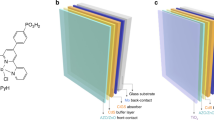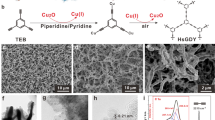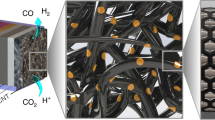Abstract
The chemical transformations that occur in metal oxides under operating conditions limit their applications for artificial photosynthesis. Understanding these chemical changes is a prerequisite to achieve sustainable production of solar fuels and chemicals. Herein, we use a correlative approach to unravel how cuprous oxide (Cu2O) photoelectrodes change under reaction conditions and, consequently, provide a protection scheme to mitigate degradation. In agreement with theoretical predictions, we find that under illumination the Cu2O concurrently undergoes reduction by photoelectrons and oxidation by holes in the material at electrolyte-dependent degradation rates. These mechanistic insights led us to design a protection scheme that uses a silver catalyst to accelerate transfer of photogenerated electrons and a Z-scheme heterojunction to extract holes. The resulting photocathode exhibits a stable photocurrent for CO2 reduction with ~60% Faradaic efficiency for ethylene with a balance of hydrogen for hours, whereas bare Cu2O degrades within minutes.
This is a preview of subscription content, access via your institution
Access options
Access Nature and 54 other Nature Portfolio journals
Get Nature+, our best-value online-access subscription
$29.99 / 30 days
cancel any time
Subscribe to this journal
Receive 12 digital issues and online access to articles
$119.00 per year
only $9.92 per issue
Buy this article
- Purchase on Springer Link
- Instant access to full article PDF
Prices may be subject to local taxes which are calculated during checkout





Similar content being viewed by others
Data availability
The authors declare that all data supporting the findings of this study are available within the paper and Supplementary Information files. Source data are provided with this paper.
References
De Luna, P. et al. What would it take for renewably powered electrosynthesis to displace petrochemical processes. Science 364, eaav3506 (2019).
Lewis, N. S. Research opportunities to advance solar energy utilization. Science 351, aad1920 (2016).
Concepcion, J. J., House, R. L., Papanikolas, J. M. & Meyer, T. J. Chemical approaches to artificial photosynthesis. Proc. Natl Acad. Sci. USA 109, 15560–15564 (2012).
Bard, A. J. & Fox, M. A. Artificial photosynthesis: solar splitting of water to hydrogen and oxygen. Acc. Chem. Res. 28, 141–145 (1995).
Lumley, M. A., Radmilovic, A., Jang, Y. J., Lindberg, A. E. & Choi, K.-S. Perspectives on the development of oxide-based photocathodes for solar fuel production. J. Am. Chem. Soc. 141, 18358–18369 (2019).
Sivula, K. & van de Krol, R. Semiconducting materials for photoelectrochemical energy conversion. Nat. Rev. Mater. 1, 15010 (2016).
Chen, S. & Wang, L.-W. Thermodynamic oxidation and reduction potentials of photocatalytic semiconductors in aqueous solution. Chem. Mater. 24, 3659–3666 (2012).
Eichhorn J., Liu G., Toma F. M. in Integrated Solar Fuel Generators (ed. Sharp, I. D. et al.) 281–303 (The Royal Society of Chemistry, 2019).
Hu, S. et al. Thin-film materials for the protection of semiconducting photoelectrodes in solar-fuel generators. J. Phys. Chem. C 119, 24201–24228 (2015).
Toe, C. Y. et al. Photocorrosion of cuprous oxide in hydrogen production: rationalising self-oxidation or self-reduction. Angew. Chem. Int. Ed. Engl. 57, 13613–13617 (2018).
Paracchino, A., Laporte, V., Sivula, K., Grätzel, M. & Thimsen, E. Highly active oxide photocathode for photoelectrochemical water reduction. Nat. Mater. 10, 456–461 (2011).
Pan, L. et al. Boosting the performance of Cu2O photocathodes for unassisted solar water splitting devices. Nat. Catal. 1, 412–420 (2018).
Schreier, M. et al. Covalent immobilization of a molecular catalyst on Cu2O photocathodes for CO2 reduction. J. Am. Chem. Soc. 138, 1938–1946 (2016).
Wu, Y. A. et al. Facet-dependent active sites of a single Cu2O particle photocatalyst for CO2 reduction to methanol. Nat. Energy 4, 957–968 (2019).
Wu, L., Tsui, L.-K., Swami, N. & Zangari, G. Photoelectrochemical stability of electrodeposited Cu2O films. J. Phys. Chem. C 114, 11551–11556 (2010).
Chavez, K. L. & Hess, D. W. A novel method of etching copper oxide using acetic acid. J. Electrochem. Soc. 148, G640 (2001).
Rajeshwar, K., de Tacconi, N. R., Ghadimkhani, G., Chanmanee, W. & Janáky, C. Tailoring copper oxide semiconductor nanorod arrays for photoelectrochemical reduction of carbon dioxide to methanol. ChemPhysChem 14, 2251–2259 (2013).
Ghadimkhani, G., de Tacconi, N. R., Chanmanee, W., Janaky, C. & Rajeshwar, K. Efficient solar photoelectrosynthesis of methanol from carbon dioxide using hybrid CuO–Cu2O semiconductor nanorod arrays. Chem. Commun. 49, 1297–1299 (2013).
Rosen, B. M. et al. The disproportionation of Cu(I)X mediated by ligand and solvent into Cu(0) and Cu(II)X2 and its implications for SET-LRP. J. Polym. Sci. A 47, 5606–5628 (2009).
Platzman, I., Brener, R., Haick, H. & Tannenbaum, R. Oxidation of polycrystalline copper thin films at ambient conditions. J. Phys. Chem. C 112, 1101–1108 (2008).
Favaro, M. et al. Understanding the oxygen evolution reaction mechanism on CoOx using operando ambient-pressure X-ray photoelectron spectroscopy. J. Am. Chem. Soc. 139, 8960–8970 (2017).
Favaro, M. et al. Unravelling the electrochemical double layer by direct probing of the solid/liquid interface. Nat. Commun. 7, 12695 (2016).
Chen, R. et al. Charge separation via asymmetric illumination in photocatalytic Cu2O particles. Nat. Energy 3, 655–663 (2018).
Li, R., Tao, X., Chen, R., Fan, F. & Li, C. Synergetic effect of dual co-catalysts on the activity of p-type Cu2O crystals with anisotropic facets. Chem. Eur. J. 21, 14337–14341 (2015).
Lam, R. K. et al. The hydration structure of aqueous carbonic acid from X-ray absorption spectroscopy. Chem. Phys. Lett. 614, 282–286 (2014).
Li, Y., Zhong, X., Luo, K. & Shao, Z. A hydrophobic polymer stabilized p-Cu2O nanocrystal photocathode for highly efficient solar water splitting. J. Mater. Chem. A 7, 15593–15598 (2019).
Chang, X. et al. Stable aqueous photoelectrochemical CO2 reduction by a Cu2O dark cathode with improved selectivity for carbonaceous products. Angew. Chem. Int. Ed. Engl. 55, 8840–8845 (2016).
Zhou, M., Guo, Z. & Liu, Z. FeOOH as hole transfer layer to retard the photocorrosion of Cu2O for enhanced photoelectrochemical performance. Appl. Catal. B 260, 118213 (2020).
Liu, G. et al. Interface engineering for light-driven water oxidation: unravelling the passivating and catalytic mechanism in BiVO4 overlayers. Sustain. Energy Fuels 3, 127–135 (2019).
Yang, J. et al. A multifunctional biphasic water splitting catalyst tailored for integration with high-performance semiconductor photoanodes. Nat. Mater. 16, 335–341 (2017).
Liu, G. et al. Enabling an integrated tantalum nitride photoanode to approach the theoretical photocurrent limit for solar water splitting. Energy Environ. Sci. 9, 1327–1334 (2016).
Kuang, Y. et al. Ultrastable low-bias water splitting photoanodes via photocorrosion inhibition and in situ catalyst regeneration. Nat. Energy 2, 16191 (2016).
Rao, H., Schmidt, L. C., Bonin, J. & Robert, M. Visible-light-driven methane formation from CO2 with a molecular iron catalyst. Nature 548, 74–77 (2017).
Tada, H., Mitsui, T., Kiyonaga, T., Akita, T. & Tanaka, K. All-solid-state Z-scheme in CdS–Au–TiO2 three-component nanojunction system. Nat. Mater. 5, 782–786 (2006).
Xia, X. et al. Latest progress in constructing solid-state Z scheme photocatalysts for water splitting. Nanoscale 11, 11071–11082 (2019).
Kang, J. & Wang, L.-W. Nonadiabatic molecular dynamics with decoherence and detailed balance under a density matrix ensemble formalism. Phys. Rev. B 99, 224303 (2019).
Zheng, F. & Wang, L.-W. Ultrafast hot carrier injection in Au/GaN: the role of band bending and the interface band structure. J. Phys. Chem. Lett. 10, 6174–6183 (2019).
Deng, X. et al. Metal–organic framework coating enhances the performance of Cu2O in photoelectrochemical CO2 reduction. J. Am. Chem. Soc. 141, 10924–10929 (2019).
Wang, M., Na, Y., Gorlov, M. & Sun, L. Light-driven hydrogen production catalysed by transition metal complexes in homogeneous systems. Dalton Trans. 33, 6458–6467 (2009).
Cheung, P. L., Machan, C. W., Malkhasian, A. Y. S., Agarwal, J. & Kubiak, C. P. Photocatalytic reduction of carbon dioxide to CO and HCO2H using fac-Mn(CN)(bpy)(CO)3. Inorg. Chem. 55, 3192–3198 (2016).
Lee, S., Park, G. & Lee, J. Importance of Ag–Cu biphasic boundaries for selective electrochemical reduction of CO2 to ethanol. ACS Catal. 7, 8594–8604 (2017).
Pan, Y., Paschoalino, W. J., Bayram, S. S., Blum, A. S. & Mauzeroll, J. Biosynthesized silver nanorings as a highly efficient and selective electrocatalysts for CO2 reduction. Nanoscale 11, 18595–18603 (2019).
Pan, L. et al. Cu2O photocathodes with band-tail states assisted hole transport for standalone solar water splitting. Nat. Commun. 11, 318 (2020).
Vayssieres, L., Beermann, N., Lindquist, S.-E. & Hagfeldt, A. Controlled aqueous chemical growth of oriented three-dimensional crystalline nanorod arrays: application to iron(III) oxides. Chem. Mater. 13, 233–235 (2001).
Kim, J. Y. et al. Single-crystalline, wormlike hematite photoanodes for efficient solar water splitting. Sci. Rep. 3, 2681 (2013).
Li, D. et al. Unraveling the kinetics of photocatalytic water oxidation on WO3. J. Phys. Chem. Lett. 11, 412–418 (2020).
Axnanda, S. et al. Using “tender” X-ray ambient pressure X-ray photoelectron spectroscopy as a direct probe of solid-liquid interface. Sci. Rep. 5, 9788 (2015).
Shao, H., Ding, Y., Hong, X. & Liu, Y. Ultra-facile and rapid colorimetric detection of Cu2+ with branched polyethylenimine in 100% aqueous solution. Analyst 143, 409–414 (2018).
Jia, W. et al. The analysis of a plane wave pseudopotential density functional theory code on a GPU machine. Comput. Phys. Commun. 184, 9–18 (2013).
Jia, W. et al. Fast plane wave density functional theory molecular dynamics calculations on multi-GPU machines. J. Comput. Phys. 251, 102–115 (2013).
Hamann, D. R. Optimized norm-conserving Vanderbilt pseudopotentials. Phys. Rev. B 88, 085117 (2013).
Wang, F., Di Valentin, C. & Pacchioni, G. Electronic and structural properties of WO3: a systematic hybrid DFT study. J. Phys. Chem. C 115, 8345–8353 (2011).
Ping, Y. & Galli, G. Optimizing the band edges of tungsten trioxide for water oxidation: a first-principles study. J. Phys. Chem. C 118, 6019–6028 (2014).
Perdew, J. P., Burke, K. & Ernzerhof, M. Generalized gradient approximation made simple. Phys. Rev. Lett. 77, 3865–3868 (1996).
Ping, Y., Goddard, W. A. & Galli, G. A. Energetics and solvation effects at the photoanode/catalyst interface: ohmic contact versus Schottky barrier. J. Am. Chem. Soc. 137, 5264–5267 (2015).
Acknowledgements
This study is based on work performed at the Joint Center for Artificial Photosynthesis, a DOE Energy Innovation Hub, supported through the Office of Science of the US Department of Energy under award no. DE-SC0004993. Some data collection and some X-ray photoelectron spectroscopy measurements were performed by the Liquid Sunlight Alliance, which is supported by the US Department of Energy, Office of Science, Office of Basic Energy Sciences, Fuels from Sunlight Hub under award no. DE-SC0021266. The computational resources were provided by National Energy Research Scientific Computing center (NERSC) located in Lawrence Berkeley National Laboratory and Oak Ridge Leadership Computing Facility at the Oak Ridge National Laboratory under the Innovative and Novel Computational Impact on Theory and Experiment project. Work at the Molecular Foundry was supported by the Office of Science, Office of Basic Energy Sciences, of the US Department of Energy under contract no. DE-AC02-05CH11231. This research used Beamline 9.3.1 of the Advanced Light Source, which is a DOE Office of Science User Facility under contract no. DE-AC02-05CH11231. The authors also thank J. Cooper for help with the design of the photoelectrochemical cell, as well as G. Panzeri at Politecnico di Milano and K. A. Persson from the University of California at Berkeley/Lawrence Berkeley National Laboratory for insightful discussions.
Author information
Authors and Affiliations
Contributions
F.M.T. and G.L. conceived the idea. F.M.T. supervised the work. G.L. synthesized the material and performed the experiments. F.Z. and L.W. designed and carried out DFT calculations. J.L. and J.W.A. performed PEC CO2 reduction and analysed the data. G.Z. conducted XPS. Y.Y., E.J.C. and J.Y. conducted APXPS and discussed the data. D.M.L. designed and fabricated the PEC cell. All the authors contributed to discussion of data interpretation. G.L., F.Z., Y.Y. and F.M.T. wrote the manuscript. All the authors contributed to the final version of the manuscript.
Corresponding author
Ethics declarations
Competing interests
The authors declare no competing interests.
Additional information
Peer review information Nature Energy thanks Martina Lessio and the other, anonymous, reviewer(s) for their contribution to the peer review of this work.
Publisher’s note Springer Nature remains neutral with regard to jurisdictional claims in published maps and institutional affiliations.
Supplementary information
Supplementary Information
Supplementary Figs. 1–36 and Table 1.
Source data
Source Data Fig. 1
Raw data associated with Fig. 1.
Source Data Fig. 2
Raw data associated with Fig. 2.
Source Data Fig. 3
Raw data associated with Fig. 3.
Source Data Fig. 4
Raw data associated with Fig. 4.
Source Data Fig. 5
Raw data associated with Fig. 5.
Rights and permissions
About this article
Cite this article
Liu, G., Zheng, F., Li, J. et al. Investigation and mitigation of degradation mechanisms in Cu2O photoelectrodes for CO2 reduction to ethylene. Nat Energy 6, 1124–1132 (2021). https://doi.org/10.1038/s41560-021-00927-1
Received:
Accepted:
Published:
Issue Date:
DOI: https://doi.org/10.1038/s41560-021-00927-1
This article is cited by
-
Cobalt-doped CdS quantum dots enhanced photoelectroreduction of CO2 to formic acid with high selectivity
Environmental Chemistry Letters (2024)
-
Chemical deposition of Cu2O films with ultra-low resistivity: correlation with the defect landscape
Nature Communications (2022)
-
Photoelectrochemical technology for solar fuel generation, from single photoelectrodes to unassisted cells: a review
Environmental Chemistry Letters (2022)



